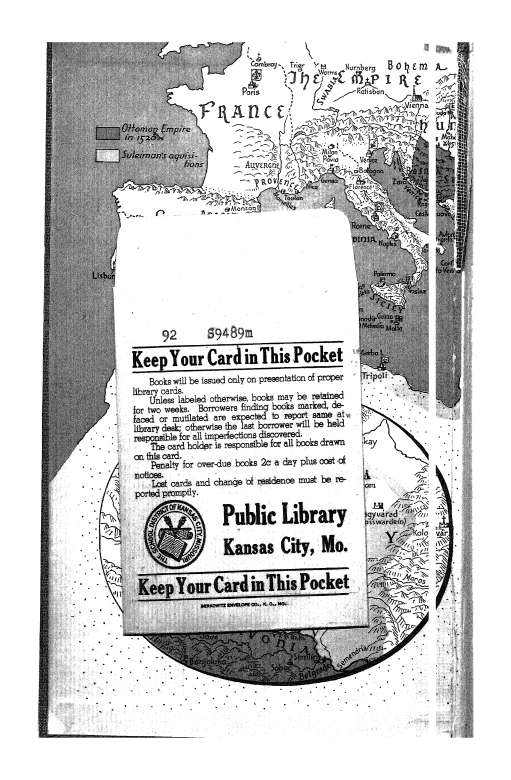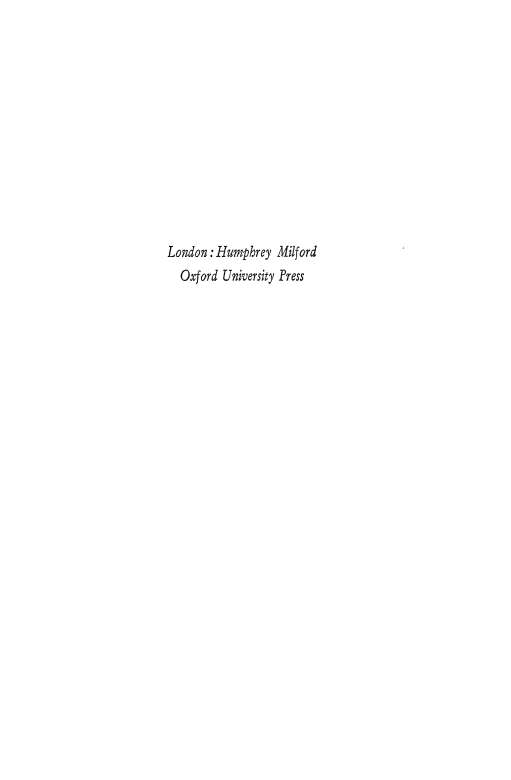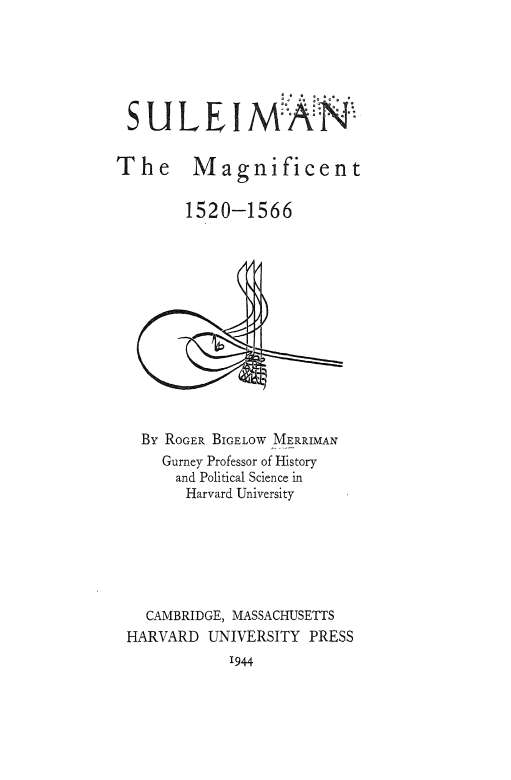Suleiman The Magnificent 1520 1566
Read Suleiman The Magnificent 1520 1566 Online
Authors: Roger Bigelow Merriman






COPYRIGHT, 1944 BY THE PRESIDENT AND FELLOWS OF HARVARD COLLEGE
Printed in the United States of America
PREFACE
I MUST BEGIN by telling my readers that this book is only partially my own. The inspiration to undertake it and a portion of the material it contains were derived from an unfinished life of Suleiman the Magnificent which was written by my beloved friend, the late Archibald Gary Coolidge in 1901-02. He and I discussed it constantly during the next five years, and I frequently urged him to complete and publish it; but other things intervened, and when he died in 1928 the manuscript was deposited in the Harvard Archives just as he had left it twenty-six years before. There, some twenty months ago, I found it, with the words "For R. B. Merriman" written in his secretary's hand on the fly leaf; and this I took as a summons to put it in shape for publication. My first intention was to leave as much as possible of his work untouched, write the three chapters which had been left undone, and edit the book under his name; but this plan did not prove practicable. So instead I have rewritten it ab initio, and made a number of changes in the original form. I hasten, however, to add that a considerable portion of Chapter I and scattering paragraphs and sentences in Chapters II-VI and IX-XI have been taken, with some revision, from Professor Coolidge's manuscript. Chapters VII, VIII, and XII are wholly my own.
No apology is offered for the fact that the following pages are chiefly a story of diplomacy and campaigns. Military considerations invariably came first in the Ottoman mind, and Suleiman was primarily a conqueror. Professor Coolidge's unfinished manuscript is even more of what has
Preface
trumpet history" than is this book, but I arri glad to take this opportunity to testify to my un-shak4n,-$dief in the doctrine which he constantly preached —namely that a knowledge of the narrative is the indispensable foundation for everything else. Constitutional, economic, social, psychological, and all the other various "aspects" of history which have been successively labelled with capital letters, and have temporarily, each in turn, held the center of the stage in recent years, are perfectly meaningless without it. Moreover they are none of them really new, as their chief proponents would have us believe; they have all been studied—without their modern titles— ever since the time of Herodotus.
I trust that the publication of this life of one of the greatest yet least known sovereigns of the sixteenth century will serve among other things to remind Harvard men all over the world of the immense debt which the University owes to Professor Coolidge. To one who, like myself, has studied and taught here for over half a century, that debt looms larger and larger as the years go by. Others have already written of his unfailing kindness, humor, and tact, of his boundless generosity and unselfishness. Here, however, I want especially to emphasize the greatness of his achievement in broadening the University's horizon. The Widener Library and the collections which he gave or obtained for it are perhaps the most conspicuous monument to his success in this respect; but the Corporation records and the University Catalogues of the last fifty years tell a no less notable tale for the curriculum. When Professor Coolidge came back to Harvard in 1893, ^ on ty undergraduate instruction given in modern history outside of the United States consisted of two general courses on Western Europe in the seventeenth, eighteenth, and nineteenth centuries; the Scandinavian, Slavic, Ottoman, and Iberian worlds were left practically untouched; the African, Asiatic, and
Latin-American ones wholly so. Two years later we find Professor Coolidge himself offering two half courses, to be given in alternate years, on the history of the Scandinavian lands and on the Eastern Question, and in 1904— 05 another on the Expansion of Europe since 1815. I n 1896 he persuaded the Corporation to embark on an even more daring adventure, and invite "Mr." (later Professor) Leo Wiener to give instruction in Slavic Languages and Literature, with the understanding that he was also to assist at the Library in cataloguing Slavic and Sanskrit books; and in 1907-08 Professor Coolidge himself offered a full course on the history of Russia. All this was the entering wedge for greater things to come, not only at Harvard but elsewhere; it deserves, in fact, to be regarded as the origin of the scientific study of Slavic history, languages, and literatures in America. A half course in Spanish history -was first given In 1903, and a professorship of Latin-American history and economics was endowed a decade later. Instruction in the history of Asia and of the African colonies was to follow in the succeeding years. For every one of these and for many other advances, Professor Coolidge was directly or indirectly responsible. Invariably he foresaw and pointed out the need. Often he gave generously to meet it, and his judgment of men was sound and keen. It has been well said of him that he was far more interested in the production of scholars than in the products of scholarship itself. To him more than to any other man is due what the Harvard History Department was able to accomplish in the days of its greatness. To us who have been brought to open our eyes to wider horizons by the tragic events of the past five years, his visions of a half-century ago seem prophetic.
When one leaves the familiar shores of Western Europe and ventures out into the Levant, one needs the safest and
wisest of pilots, and I have been fortunate in finding them. The names of two friends—Professor A. H. Lybyer of the University of Illinois, and Professor R. P. Blake of Harvard—stand at the head of the list. The one has gone through my galleys and the other my manuscript with the most assiduous care, and both have saved me from countless errors and told me much I did not know. Rev. J. K. Birge, Chairman of the Publication Department of the Near East Mission of the American Board, has generously placed his intimate knowledge of Turkish and modern Turkey at my disposal Dr. Erwin Raicz, of the Harvard Institute of Geographical Exploration, has drawn the map, and incidentally taught me much about the Danube campaigns. Such accuracy as the note on the portraits of Suleiman may be found to possess is chiefly due to the liberal help of Dr. A. Weinberger of the Houghton Library at Harvard, of Mr. W. G. Constable of the Boston Museum of Fine Arts, and of Miss Agnes Mongan and Miss Margaret Gilman of the Fogg Art Museum; and the officials of the Harvard and Yale University Libraries have facilitated my researches in many different ways. Mr. G. W. Robinson has given me all sorts of precious, aid—as he has with other volumes, during the past thirty years and more. My wife has been my sympathetic critic, collaborator, and companion from first to last; without her constant encouragement this book would never have been finished.
R. B. M.
Cambridge, Massachusetts September, 1944
CONTENTS
I. EARLY HISTORY OF THE OTTOMAN TURKS I
II. YOUTH AND ACCESSION OF SULEIMAN. CONTEMPORANEOUS EUROPE 27
III. BELGRADE AND RHODES 50
IV. MOHACS 76 V. THE SIEGE OF VIENNA AND ITS AFTERMATH 97
VI. RELATIONS WITH FRANCE TO 1536 126
VII. THE GOVERNMENT 145
VIII. THE SERAGLIO; THE HAREM; THE SULTAN AND
HIS SUBJECTS 175
IX. WAR AND VICTORIES IN THE MEDITERRANEAN;
KHAIREDDIN BARBAROSSA 206
X. PERSIA, INDIA, AND ABYSSINIA 234
XL HUNGARY AGAIN: I 53 3--1564 257
XII. MALTA AND SZIGET 274
Note on the Portraits of Suleiman 293
Bibliographical Note 301
Bibliographical Notes on the Separate
Chapters 305
Abbreviations 31 ^
SULEIMAN THE MAGNIFICENT IN 1559 Frontispiece
Adelchior Lorichs
SULEIMAN IMPERATOR IN 1526 76
Albrecht Diirer
SULEIMAN IN PROCESSION THROUGH CONSTANTINOPLE
IN 1533 174
Peter Coeck van Aelst
SULEIMAN THE MAGNIFICENT IN 1548 258
Michael Ostendorfer
Early History of the Ottoman Turks
lew periods in history possess such fascination as the first half of the sixteenth century. All over Western Europe the spirit of the Renaissance had triumphed, and was wakening the human mind to ever greater activity. It was a golden age of art, of letters, and of science: an age of daring exploration and adventure, of passionate religious emotion and controversy. The discoveries of da Garna and Columbus had opened up new worlds to European enterprise; the teachings of Luther and his successors rent hopelessly in twain the Western Church of the Middle Ages. It was also an epoch of decisive moment in the growth of nations. Italy became at once the intellectual guide and the political prey of ruder and stronger powers. The Holy Roman Empire of the German people, though internally more disrupted than ever, was officially headed by the mighty House of Hapsburg, the marvellous success of whose marriage policy had already won it the lordship of the Netherlands and the kingship of the Iberian realms, and promised the speedy realization of its traditional aim: Austrme est imperare orbi unwerso. France and England, consolidated under the strong rule of the Valois and the Tudors, were full of youthful life and energy and eager to expand, while Spain in a few short years acquired the largest empire on the globe. In this age of intense activity the leading figures stand out with unprecedented clearness. The spirit of the Renaissance was above all individualistic, and at no time in the annals of mankind do we find a greater number of
^ Suleiman the Magnificent
outstanding personalities in the political as well as in the religious and artistic world. The Spain, the France, and the England of that day at once recall the names of Charles V, Francis I, and Henry VIII: all men of mark, who played no small part in making history, and well deserve the study and scholarship that have been lavished on them,
Modern historians, however, have devoted singularly little attention to one meriting it equally well, the fourth great sovereign of the time, Suleiman "the Magnificent," "the Great," "the Lawgiver"~~the ruler of the Ottoman Empire at the height of its glory and strength, a conqueror of many lands, whose fleets dominated the Mediterranean and whose armies laid siege to Vienna, whom Francis I of France addressed as a suppliant, and to whom Charles V's younger brother Ferdinand paid tribute. A great English historian has justly observed that "the thrones of Europe were now filled by the strongest men who ever contemporaneously occupied them. There may have been greater sovereigns than Charles, Henry, Francis, and Solyman, but there were never so many great ones together, of so well-consolidated dominion, so great ability, or so long tenure of power." a Of that remarkable quartet the Turkish Sultan was assuredly not the least. In the politics of Western Europe his influence was profound, for he played a more decisive part in the struggle between Charles V and Francis I than did Henry VIII of England, and the danger of a Turkish invasion of Germany continually affected the course of the Protestant Reformation. The history and character of Suleiman are also of lively interest in themselves. He was the last and perhaps the greatest of that extraordinary series of able rulers who built up the Ottoman state from a little vassal principality into a mighty empire, and made it the terror of Christendom. He was equally noteworthy as a warrior and a statesman, and his private
••" * WHIIam Stubbs, Lectures on European History (London, 1904), p. 122.
character, though stained by a few acts that even his inherited surroundings and traditions cannot excuse, was yet such as to command the admiration of his enemies. But, before attempting to portray him, we must devote the rest of this chapter to a hasty sketch of his predecessors, who made his reign possible. No other line in all history can show such a long and almost uninterrupted succession of really remarkable men.
In the middle of the thirteenth century events of high importance were taking place both in the Christian and in the Mohammedan worlds. The death of the Emperor Frederick II ("Stupor Mundi") on December 13, 1250, marked the end of the greatness of the mediaeval Empire. The Latin Empire of the East, the chance foundation (1204) of misdirected crusaders, was nearing the close of its short and inglorious span of life; in 1261 Constantinople was recaptured by the Greeks, Russia had just fallen under the terrible yoke of the Mongols, who delayed for centuries her participation in the affairs of Western Europe. England was becoming increasingly restless under the misgov-ernment of Henry III. In the Mediterranean lands the conflict between Cross and Crescent still continued with varying fortunes. In the Iberian Peninsula the tide had definitely turned in favor of the former, and the Moors had lost all their possessions save the little realm of Granada. But farther east the Christian kingdom of Jerusalem had been almost obliterated, and St. Louis had been defeated and made prisoner at Mansurah in Egypt, where internal troubles led shortly afterward to the establishment of the first Mameluke dynasty. It was at this juncture, when Western Asia was already threatened by the Mongol attack soon destined to overwhelm Baghdad and put an end to the Abbasside Caliphate, that, according to a more or less credible tale, a wandering adventurer from the east-
ward, at the head of a small following, plunged into a battle that was being fought on the Anatolian plateau.
This unexpected combatant was a warrior named Erto-ghrul, and he belonged to another tribe of the same race as the Seljuk Turks, who had defeated the East Roman Emperor at the battle of Manzikert in 1071, and subsequently overran the whole interior of Asia Minor. Broadly speaking, the name Turk (Turcae}, which we find in the classical writers of the early Christian era, may be used to designate that section of the Finno-Ugric inhabitants of the great steppes of Asia which was the more Western and Caucasian in its affiliations; while the other, which looked towards China, is called Mongol. These tribesmen had no race prejudices: they had mingled freely from the earliest times with their white neighbors on the West, and their yellow ones to the eastward; "the Turkish peoples (for the Western world) are then in general those Tatars who have had the greatest admixture of Caucasian blood." 2 They were divided into many tribes, of which few save the Seljuks had yet reached a stage much more advanced than the nomadic; the small band led by Ertoghrul formed the remnants of one of the lesser of them. 3 It would appear that he did not even know the names of the combatants in the battle which he had joined, but he was chivalrous enough to take the weaker side. It was only after victory had been won by his aid that he learned that he had assisted Kay-Kubad, the Seljuk Turkish Sultan of Rum (or Iconium), against a Mongol army. The Sultan, in gratitude, took